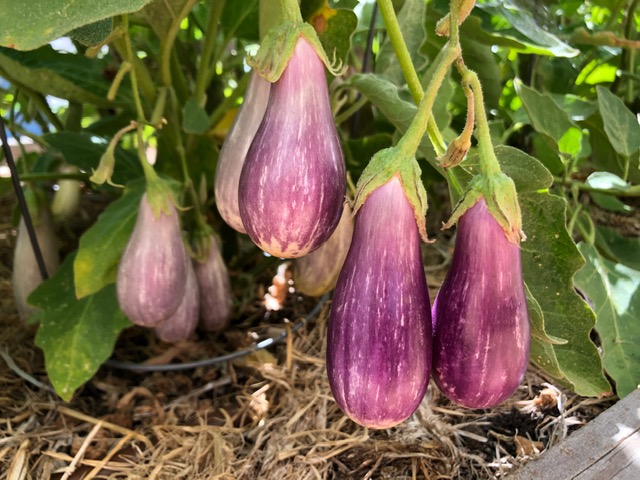

|
|
Keep those summer crops harvested, and they'll continue producing into fall. (Photo: Kathy Morrison)
|
Hot and smoky; those may be favorable qualities for a spicy pepper, but not for the weather.
Unfortunately, orange haze continues to tint our skies as smoke from the Dixie Fire and other blazes accumulates in the Central Valley. Meanwhile, Sacramento area temperatures are again spiking over 105.
According to the National Weather Service, Sacramento will be under a heat advisory now through at least Sunday night. Predicted high for Sunday in Sacramento: 106 degrees. Keeping this oven baking are low temperatures in the 70s, 10 degrees above average for mid-August.
Monday also should see triple digits in the afternoon, but then we’ll finally get some overnight relief. Tuesday’s high is forecast for “only” 92 degrees – normal for this time of summer. For the rest of the week, lows are expected to dip back down to 60 or 61 degrees, helping to keep daytime highs in check. The weather service forecasts low to mid 90s Tuesday into next weekend.
So, take it easy this weekend. Don’t stress in this heat and bad air. Instead, wait until temperatures cool down a little before tackling major chores, fertilizing or planting. That cool-down will be here soon.
* Harvest tomatoes, beans, squash, pepper and eggplants to prompt plants to keep producing.
* Give your veggies a deep watering twice a week, more if planted in containers.
* After watering, give tomatoes, peppers and other non-leafy veggies a boost with phosphate-rich fertilizer to help set fruit. Feed every other week.
* Watch out for caterpillars and hornworms in the vegetable garden. They can strip a plant bare in one day. Pick them off plants by hand in early morning or late afternoon.
* Mulch can be your garden's best friend; it conserves moisture while blocking out weeds. But don't let mulch mound around stalks, stems or trunks. That can promote rot.
* Camellia leaves looking a little yellow? Feed them some chelated iron. That goes for azaleas and gardenias, too.
*Feed citrus trees their last round of fertilizer for the year. This will give a boost to the fruit that's now forming.
* Pinch off dead flowers from perennials and annuals to lengthen their summer bloom.
* Dead head roses.
* Pick up after your fruit trees. Clean up debris and dropped fruit.
* In the garden, direct seed beets, bush beans, carrots, leaf lettuce and turnips.
* Plant potatoes.
* Indoors, start seedlings for fall vegetable planting, including bunching onion, cabbage, broccoli, cauliflower, kale, radicchio and lettuce.
Comments
0 comments have been posted.Sacramento Digs Gardening to your inbox.
Food in My Back Yard Series
April 22: Should you stock up on fertilizer? (Yes!)
April 15: Grow culinary herbs in containers
April 8: When to plant summer vegetables
April 1: Don't be fooled by these garden myths
March 25: Fertilizer tips: How to 'feed' your vegetables for healthy growth
March 18: Time to give vegetable seedlings some more space
March 11: Ways to win the fight against weeds
March 4: Potatoes from the garden
Feb. 25: Plant a fruit tree now -- for later
Feb. 18: How to squeeze more food into less space
Feb. 11: When to plant? Consider staggering your transplants
Feb. 4: Starting in seed starting
Sites We Like
Garden Checklist for week of April 27
Once the clouds clear, get to work. Spring growth is in high gear.
* Set out tomato, pepper and eggplant transplants.
* From seed, plant beans, beets, cantaloupes, carrots, corn, cucumbers, melons, pumpkins, radishes and squash. Plant onion sets.
* In the flower garden, plant seeds for asters, cosmos, celosia, marigolds, salvia, sunflowers and zinnias. Transplant petunias, zinnias, geraniums and other summer bloomers.
* Plant perennials and dahlia tubers for summer bloom. Late April is about the last chance to plant summer bulbs, such as gladiolus and tuberous begonias.
* Transplant lettuce and cabbage seedlings.
* Weed, weed, weed! Don’t let unwanted plants go to seed.
* April is the last chance to plant citrus trees such as dwarf orange, lemon and kumquat. These trees also look good in landscaping and provide fresh fruit in winter.
* Feed citrus trees with a low dose of balanced fertilizer (such as 10-10-10) during bloom to help set fruit. Keep an eye out for ants.
* Apply slow-release fertilizer to the lawn.
* Thoroughly clean debris from the bottom of outdoor ponds or fountains.
* Start thinning fruit that's formed on apple and stone fruit trees -- you'll get larger fruit at harvest (and avoid limb breakage) if some is thinned now. The UC recommendation is to thin fruit when it is about 3/4 of an inch in diameter. Peaches and nectarines should be thinned to about 6 inches apart; smaller fruit such as plums and pluots can be about 4 inches apart. Apricots can be left at 3 inches apart. Apples and pears should be thinned to one fruit per cluster of flowers, 6 to 8 inches apart.
* Azaleas and camellias looking a little yellow? If leaves are turning yellow between the veins, give them a boost with chelated iron.
* Trim dead flowers but not leaves from spring-flowering bulbs such as daffodils and tulips. Those leaves gather energy to create next year's flowers. Also, give the bulbs a fertilizer boost after bloom.
* Pinch chrysanthemums back to 12 inches for fall flowers. Cut old stems to the ground.
* Mulch around plants to conserve moisture and control weeds.